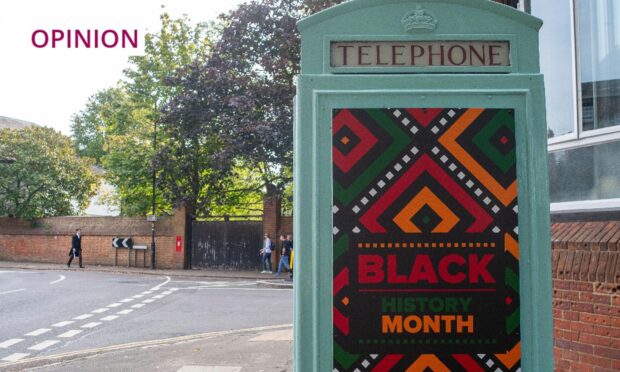Black History Month during October is a wonderful way to acknowledge the contributions and achievements of Black people, come together as allies, and take steps to enable success and wellbeing.
Since moving to Aberdeen in 2017, with its international connections, I’ve had the pleasure of meeting people from so many different backgrounds, nationalities and cultures. We’re all citizens at a local and global level.
Being global citizens encompasses our collective responsibilities to people and planet; social justice actions we can all take to create fairer communities that enable everyone to thrive. To acknowledge all of that, this year’s Black History Month theme at Robert Gordon University is “celebrating our diverse communities: global citizens at RGU and beyond”.
If we are to address local ambitions of sustainable communities and the United Nations sustainable development goal of reduced inequalities, we need to work collectively. I’m delighted, therefore, to see local organisations like Aberdeen City and Aberdeenshire Councils, RGU, the University of Aberdeen, Nescol, north-east police, NHS Grampian, the Grampian Regional Equality Council and many others coming together through a shared goal and plenty of passion to form an anti-racist roundtable.
These organisations are taking a long, hard look at their practices, policies, and diversity data in order to identify where they can do better.
Now, more than ever, with widening inequalities coming to the fore during the pandemic, geopolitical human suffering and local inequality, we need to take action. It’s wonderful to see the roundtable members planning future collaborative work.
The three Cs – connect, create, celebrate
To be meaningful, Black History Month efforts for race equity need to go beyond the month of October. I use a framework of three Cs: connect, create, celebrate. This encourages us to connect with diverse communities, create inclusive practices and, my favourite C, to celebrate our individual and global identities all year round.
In my role as an equality champion, and as a person of mixed heritage, I always advocate through a lens of positivity and celebrating diversity, but let us not shy away from, or be in denial of, the very real fact that on our doorstep there are still those who face challenges and barriers, and that bias and discrimination still exist.
What is Black History Month? Emmanuel, RGU's Equality, Diversity and Inclusion Advisor, has it covered…
➡️ https://t.co/PdLW0Oszer#BlackHistoryMonth #BHM2023 #BlackHistoryMonth2023 pic.twitter.com/Q24xrjRVz8
— Robert Gordon University (RGU) (@RobertGordonUni) October 3, 2023
As the Persian poet Saadi Shirazi wrote in his poem Bani Adam (meaning sons of Adam or humankind) which decorates the walls of the United Nations headquarters in New York: “Human beings are members of a whole, in creation of one essence and soul. If one member is afflicted by pain, other members uneasy will remain.”
Black History Month, therefore, is an opportunity for each of us to reflect on what we can do, from educating ourselves on microaggressions and inclusive language to engaging in cultural conversations. At a community level, this could involve reaching out to our diverse peers, friends and neighbours, creating safe spaces to have honest conversations, and co-creating measures to bridge inequality gaps.
How to support and encourage equality at work
In our workplaces, we can support the efforts of equality champions, be active allies and offer to mentor a colleague by taking the first step to building welcoming relationships.
We can foster representative leadership through enabling diverse talent pipelines. We can be more inclusive with who we invite to the table, with who is heard and offered opportunities. Do we always have the same faces in our projects or teams, or could we be more intentional in widening our circle and empowering the lesser-heard voices to succeed?
I have been humbled by colleagues and students who have kindly and bravely shared their lived experiences so that, together, we can raise awareness
Across education, we can ensure our curricula are diverse, with a global perspective, nurture respect and compassion, and honour past and present Black trailblazers.
I have been humbled by colleagues and students who have kindly and bravely shared their lived experiences so that, together, we can raise awareness. I urge everyone to consider what they can do to “connect, create, celebrate”, however big, small or tiny.
Every effort matters. Drop by drop becomes an ocean, and this helps create equity for all, allowing everyone to feel a sense of belonging and well-being.
Leila Neshat Mokadem is a senior lecturer and staff equality champion at Robert Gordon University











Conversation